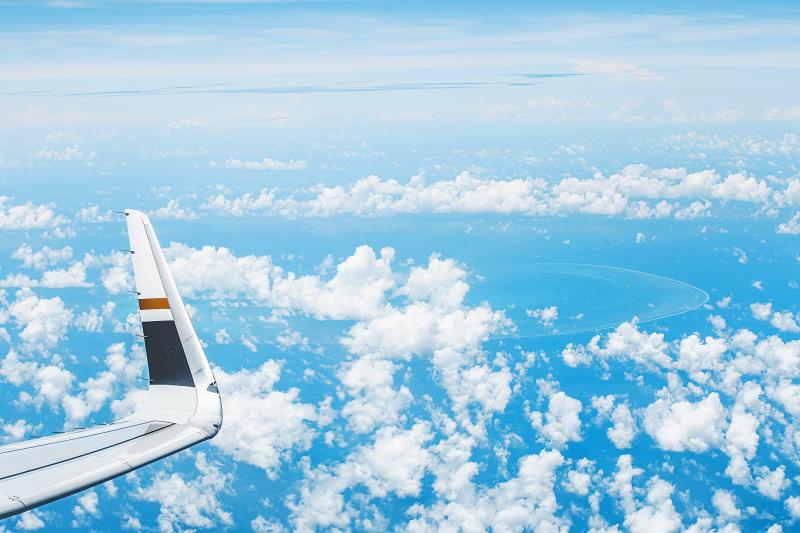Taiwan must build the Pratas Islands (Dongsha Islands, 東沙群島) into a key position for the defense of the southwestern air defense identification zone (ADIZ), a researcher at the Institute for National Defense and Security Research said.
In an article published on the think tank’s Web site on Friday, Huang Chung-ting (黃宗鼎), an assistant research fellow at the Ministry of National Defense, wrote that when 52 Chinese People’s Liberation Army (PLA) aircraft entered the southwestern ADIZ on Monday last week, they passed near the Pratas.
It was the largest incursion into the zone since the ministry started publicizing such information in September last year.

Photo courtesy of StarLux Airlines
The first Taiwanese position near the route the aircraft took is the Pratas, which makes its defense integral to maintaining security across the Taiwan Strait and in the South China Sea, he said.
The fall of the Pratas to Chinese forces would create a breach in Taiwan’s defensive perimeter and allow China to create a chokehold on the flow of commerce in the South China Sea, he added.
The Pratas face a multitude of military risks, which could be divided into potential or major threats, he said.
China could launch an amphibious assault utilizing a Type 726 landing craft air cushion, a hovercraft capable of carrying tanks, from bases in the Pearl River Basin 200km away, Huang said.
Another potential danger is the PLA Navy’s Type 054A guided-missile frigates, which have a weapons range of 120km and are known to operate in the area, he said.
Most significantly, Chinese military forces could impose an air-sea blockade or launch a combined strike against the atoll, he added.
The lines of communication from Pratas to Taiwan could be severed by PLA aircraft and vessels operating to its north and east, an area that overlaps with the southwestern ADIZ, he said.
Since last month, China has increasingly used mixed formations of J-16 and SU-30 fighters, H6 bombers, and KJ-500 airborne early warning and control systems in intrusions near the atoll, he said.
The formations constitute powerful strike groups capable of attacking the Pratas or Taiwanese flotillas attempting to relieve or resupply the outpost, he said.
This means that the area is ideal for establishing a forward warning, reconnaissance and surveillance outpost for the defense of the southwestern ADIZ, he said.
The atoll’s defenses were set up in 2012 to fight off helicopters or drones, but more powerful weapons would surely be deployed against the Pratas in an attack, he said.
Moreover, Taiwanese efforts to retake the atoll, should it fall to China, would play to the PLA’s advantages, as encircling a strong point to strike at a relief force is part of Chinese military doctrine, he added.
Marine units seeking to retake the Pratas would be exposed to anti-ship missile fire, while army special forces rely on C-130 cargo planes that are vulnerable to missiles, he said.
Even if a counterattack succeeded in retaking the outpost, it would soon be attacked by retaliatory long-range fire or bombing, he said.
The government would need to balance national security needs and priorities such as stopping the incursions of Chinese dredging and fishing boats, and conducting environmental research in the area, he added.

Civil society groups yesterday protested outside the Legislative Yuan, decrying Chinese Nationalist Party (KMT) efforts to pass three major bills that they said would seriously harm Taiwan’s democracy, and called to oust KMT caucus whip Fu Kun-chi (傅?萁). It was the second night of the three-day “Bluebird wintertime action” protests in Taipei, with organizers announcing that 8,000 people attended. Organized by Taiwan Citizen Front, the Economic Democracy Union (EDU) and a coalition of civil groups, about 6,000 people began a demonstration in front of KMT party headquarters in Taipei on Wednesday, organizers said. For the third day, the organizers asked people to assemble

Taipei is participating in Osaka’s Festival of Lights this year, with a 3m-tall bubble tea light installation symbolizing Taiwan’s bubble tea culture. The installation is designed as a bubble tea cup and features illustrations of Taipei’s iconic landmarks, such as Taipei 101, the Red House and North Gate, as well as soup dumplings and the matchmaking deity the Old Man Under the Moon (月下老人), affectionately known as Yue Lao (月老). Taipei and Osaka have collaborated closely on tourism and culture since Taipei first participated in the festival in 2018, the Taipei City Department of Information and Tourism said. In February, Osaka represented

POOR IMPLEMENTATION: Teachers welcomed the suspension, saying that the scheme disrupted school schedules, quality of learning and the milk market A policy to offer free milk to all school-age children nationwide is to be suspended next year due to multiple problems arising from implementation of the policy, the Executive Yuan announced yesterday. The policy was designed to increase the calcium intake of school-age children in Taiwan by drinking milk, as more than 80 percent drink less than 240ml per day. The recommended amount is 480ml. It was also implemented to help Taiwanese dairy farmers counter competition from fresh milk produced in New Zealand, which is to be imported to Taiwan tariff-free next year when the Agreement Between New Zealand and

IDENTITY SHIFT: Asked to choose to identify as either Taiwanese or Chinese, 83.3 percent of respondents chose Taiwanese, while 8.4 percent chose Chinese An overwhelming majority of Taiwanese, 71.5 percent, think that Taiwan should compete in international competitions under the name “Taiwan,” a Taiwan Brain Trust survey published yesterday showed. Referring to Taiwan’s victory last month at the World Baseball Softball Confederation’s Premier12, the survey results showed that 89.1 percent of respondents said that Taiwan’s exceptional performance in sporting competitions furthers national unity. Only 18.8 percent of respondents supported Taiwanese teams’ continued use of the name “Chinese Taipei” in international sporting competitions, the survey showed. Among Taiwan’s leading political parties, the name “Team Taiwan” was supported by 91.1 percent of self-identified Democratic Progressive Party (DPP) supporters,